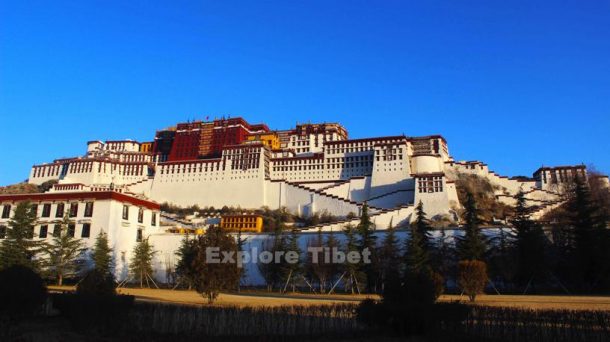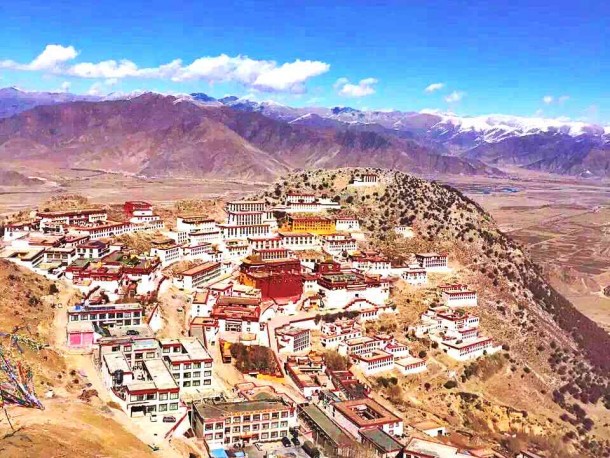Top Attractions of a Lhasa City Tour
Tibet is a land of mystery and mysticism. One of the last places on the planet where you can experience one of history’s most timeless religions and where you can visit the stunning monasteries that Buddhism has brought about. In this ancient and timeless land, Buddhism is a major religion, one which has become so intertwined with the Tibetan culture that it is almost impossible to tell one from the other. Every aspect of Tibetan life has some form of religious ritual to it, many of them forming part of the Tibetan’s devout religious belief and the journey towards enlightenment.

Barkhor Street in Lhasa City
Lhasa city is one of the world’s most stunning cities. And with all that it has to offer, you should give yourself plenty of time to explore its mysteries and wander the cobbled alleys. And backstreets to discover its secrets. With its deep-seated roots in the Buddhist religion, any traveler to Lhasa will be amazed at the impressive palaces and ancient monasteries that the city has to offer.
Table of Contents
Potala Palace
The Potala Palace is the most visible landmark in Lhasa city. Therefore, it can be seen for miles around the outside of the city. Potala Palace lies on the small hill known as Moburi, over 100 meters above the city itself. The palace is actually the highest ancient palace in the world. At its highest point, it reaches an altitude of almost 3,750 meters above sea level. The palace lies on the site of an ancient 7th-century fortress and was constructed in its present form by the 5th Dalai Lama in 1645.

Potala Palace in Lhasa, Tibet
Once the seat of Tibetan government, the palace has more than 1,000 rooms and covers an area on the top of the hill of around 32 acres. Its massive stone walls measure almost 3 meters thick at the base. Tapering up to the higher ramparts, which are still more than a meter thick at the top of the structure. The palace has stood for maybe around 350 years as a testament to Tibetan architecture. It is revered around the world as one of the most stunning buildings in Tibet. The Potala Palace has two parts, the Red Palace and the White Palace. This monumental building is topped by a gilded roof that shines in the sun, reflecting the glory of the building itself.
Red Palace
The Red Palace is the main prayer house of the monks and the Dalai Lama and is dedicated to the study of Buddhism in Tibet. Containing almost 20 chapels, the Red Palace also contains the mausoleums of the previous Dalai Lamas. Each built to honor the dead incarnation of the living Buddha. However, the mausoleum of the 5th Dalai Lama dwarfs them all, standing five stories high and covered in gold, pearls, and rare diamonds.
White Palace
The White Palace was the part of the Potala that once housed the offices of the government of Tibet during the time of its theological rule by the Dalai Lama. It was home to ten successive incarnations of the Dalai Lama as his personal apartments. Constructed by the fifth Dalai Lama, a part of the ancient fortress built by the Tibetan king, Songtsen Gampo. It still remains in the west of the White Palace.
Jokhang Temple
Jokhang Temple in Lhasa, whose name means “House of Buddha”. Furthermore, It is the spiritual center is Tibetan Buddhism and the oldest temple of its kind in Tibet. The primary seat of the Gelug School of Tibetan Buddhism. It was originally constructed in 647 AD to house the statues of Buddha. While that was brought to Tibet by the wives of Songtsen Gampo from China. The temple lies in the middle of Lhasa. On the site of what was once a small lake in the city that was filled in to counter the evil demons that resided within.

In front of Jokhang Temple in Lhasa
It is the most sacred temple in Tibet. The Jokhang is the terminus of thousands of pilgrims that travel the length and breadth of the plateau every year to prostrate themselves in prayer at its gates. Every day, in the courtyard of the temple, many pilgrims and local Tibetans can be seen performing the five-point prostration. It is the form of prayer in Buddhism that is deemed to be the ultimate in worship rituals.
The central hall of the temple is where the life-sized statue of the Sakyamuni Buddha resides. It was brought to Tibet by the Tang Dynasty Princess Wencheng on the occasion of her marriage to the Tibetan king. This stunning gilded statue of a 12-year-old Buddha sits in the most elaborate setting. It is covered with clothes and robes adorned with gems and jewels and fringed with gold brocade. For centuries, it has been the object of prostration by pilgrims from all across Tibet, and even other places around the world.
Sera Monastery
It is located around six kilometers to the north of the Jokhang Temple. Sera Monastery is one of the largest monasteries in Lhasa. And one of the Great Three monasteries of the Gelugpa School of Tibetan Buddhism. It was constructed in 1419. The monastery lies at an elevation of almost 4,000 meters. Probably, it is one of the most visited monasteries in Lhasa.
The main attractions for tourists to Sera Monastery are the unique debates of the monks that happens every afternoon in the debating courtyard. The monks debate the theological and theosophical aspects of the scriptures as a means to learn more of the doctrines and gain a better understanding of their meanings.

Sera Monastery Debating Session
The debates are lively and articulate with many gestures, including the clapping of hands and stamping of the feet. The debates are open for onlookers to see. And the debating courtyard is a delightful gravel courtyard dotted with ancient elms and birch trees to provide shade from the afternoon sun. Hence, the visitors are advised to remain silent, however, so that they do not disturb the monks in their debates.
Drepung Monastery
The Drepung monastery is one the first of the Great Three monasteries of the Gelugpa School of Tibetan Buddhism. Likewise, it is the largest Buddhist monastery in Tibet. The original home of the Dalai Lama prior to the construction of the Potala Palace and Norbulingka. The monastery lies around eight kilometers to the west of the Potala Palace at an altitude of around 3,800 meters.

Explore Tibet guests visit Drepung Monastery
A collection of grand white buildings, the monastery stands out starkly against the dark backdrop of the surrounding mountains. It is one of the most prized relics of Tibetan Buddhism is housed in the Great Sutra Chanting Hall of the Drepung Monastery. According to the local records, when the monastery was constructed, a magical conch shell was discovered by the founder, Tsongkhapa. It is believed to have been buried there by Buddha himself. Visitors are allowed into the halls, but only during the morning. While they are closed for prayers in the afternoons.
Ganden Monastery
Ganden monastery is located on the southern bank of the Lhasa River. It is around 60 kilometers from the center of Lhasa. Ganden Monastery is one of the earliest Buddhist monasteries in Tibet. One of the largest monasteries in Tibet. It was built in the 15th century by the founder of the Gelugpa School of Tibetan Buddhism, Tsongkhapa. As the highest-ranking monastery in the Gelug School. Hence its abbots are also the abbots of the entire school of Tibetan Buddhism. Above all, outranked only by the Dalai Lama and the Panchen Lama.

Ganden Monastery in Lhasa
The monastery is made up of more than 50 structures. And the main halls and Main Assembly Hall are found in the main temple structure. The monastery has four main halls, the Coqen Hall, the Sutra Hall, the Buddha Halls, and the Holy Stupa Hall, as well as many other rooms. The main buildings also house the famous Tri Thok Khang. The bed-chamber of Tsongkhapa and the abbots that followed. The hall houses statues of the Sitatapatra and Manjushri Bodhisattva. And likewise, the windows are made of ornately carved wood in the style of the Central Plains of Tibet.
So, these are the most famous attractions in the Lhasa city, Tibet.
Recent Posts
Where to Start Your Tibet Trip
The Rich Tapestry of Tibet’s Monastic Culture
How to Visit Tibet
All Categories
- About Tibet
- book a Tibet tour
- Buddhism Practice
- Budget Tour
- China-Tibet Train
- Customized Tibet tour
- Historical Sites
- Hot Springs in Tibet
- News
- Photography in Tibet
- Tibet attraction
- Tibet Group Visa
- Tibet Motorcycle Tour
- Tibet Small Group Tours
- Tibet Tours and Tibetan Tour Guide
- Tibet Train
- Tibet Travel FAQs
- Tibet Travel Information
- Tibet Travel News
- Tibet Travel Permit Update
- Tibet Travel Prices Rises
- Tibet Trek
- Tibet Trekking Tour
- Tibet weather and climate
- Tibet Wildlife animals
- Tibet Winter Tour
- Tibetan Buddhism
- Tibetan Cultural Features
- Tibetan Culture and Poeple
- Tibetan Festivals
- What to see in Tibet



